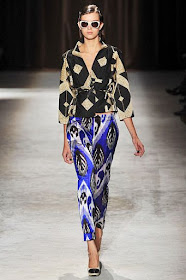 |
| Most Kyrgyz trolleybuses are not Salvador Dali-themed. This one was sprayed by the DOXA art group in Bishkek. Image taken from Kloop.kg. Creative commons. |
While over the years they have ceded prominence to the more manoeuvrable but widely despised marshrutka (minibus) they have retained their position as the public transport of the heart, offering residents a slower, cheaper and more pacifying ride between key points in the city of one million people.
Oh, and they reduce carbon emissions, too.
Over the last two or so years, American researcher Ryan Johnson has been providing Twitter with snapshots of life from behind the wheel of Bishkek's trolleybuses. The
The trolleybus below, adorned with a drape featuring typical Kyrgyz nomadic patterns, is captured by Johnson looking out at public enemy No.1, the marshrutka.
The rich blue floral pattern on the hanging framing this next trolleybus is more redolent of Kyrgyzstan's neighbour Uzbekistan, recalling the fabled Silk Road cities of Samarkand, Bukhara and Khiva. Sunglasses are kept in reserve for brighter weather.
This trolleybus is big on roses and butterflies. Unfortunately driving while talking on a mobile phone is not yet taboo in Bishkek, a city where fatal road accidents are commonplace.
Some trolleybus drivers trust lucky charms and Islamic scripture to help them navigate their way through the city's perilous thoroughfares, but others believe in the Russian saying “деньги к деньгам”, or ‘money brings money’.
Our next trolleybus proudly displays banknotes from Kyrgyzstan, as well as one from Uzbekistan and another from Turkmenistan. This version of the Turkmen manat banknote (bottom row, furthest right), which has now gone out of circulation, bears the image of the gas-rich country's former president, Saparmurat Niyazov.
Roads in Bishkek are generally in poor condition, much to the chagrin of all drivers. Because of the poor roads, cracked windshields are almost universal.
At 8 som (12 US cents), the trolleybus is more affordable than the 10 som marshrutka, and ten times as cheap as a taxi across town.
Moreover, they are much better ventilated, a fact generally appreciated when the weather warms up.
Sometimes, the driver makes his rounds with a friend or his wife.
This, along with a random vase of fake flowers, adds to the feeling that you are a fly on the wall in someone's living room rather than a customer riding public transport.
This delightful article was first published on 29 March 2017 on Global Voices Online. It was written by the Akhal-Tech Collective, a group of bloggers and journalists writing about the Central Asian region.
Related posts: Kyrgyzstan: The Hermes Scarf and the Appaloosa Horse
All-Woman Brewery Brings Craft Beer to Kyrgyzstan
Bishkek's Mosaics: Fragmented Dream Project
6 Quirky Things About Kyrgyzstan










